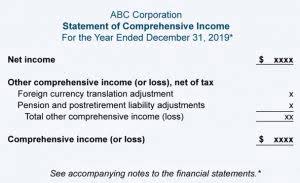Content


These statements, which include the Balance Sheet, Income Statement, Cash Flows, and Shareholders Equity Statement, must be prepared in accordance with prescribed and standardized accounting standards to ensure uniformity in reporting at all levels. Contingent Liability is the company’s potential liability, which depends on the happening or non-happening of some contingent event in the future that is beyond the company’s control. Example of contingent liabilities includes potential pending lawsuits from the company, warranties given, etc. The Interpretations Committee noted that when the IASB withdrew IFRIC 3, it affirmed that IFRIC 3 was an appropriate interpretation of existing IFRS for accounting for the emission trading schemes that were within the scope of IFRIC 3. However, the IASB acknowledged that, as a consequence of following existing IFRS, IFRIC 3 had created unsatisfactory measurement and reporting mismatches between assets and liabilities arising from emission trading schemes.
Suppose ABC Ltd. is a pharmaceutical company developing a formula of medicine that cures diabetes. At the same time, another pharmaceutical company XYZ Ltd. filed a lawsuit of $1,000 million against ABC Ltd. for theft of its patent/know-how. In that case, ABC Ltd. records this contingent liability in their books of accounts.
- The books of the Head Office and Lebanese branches of the Bank were reviewed by the National Social Security Fund and were subject to a discharge for the period from 1 March 1998 until 31 October 2014.
- Examples include liabilities arising from lawsuits, discounted notes receivable, income tax disputes, penalties that may be assessed because of some past action, and failure of another party to pay a debt that a company has guaranteed.
- Various lawsuits and claims, including those involving ordinary routine litigation incidental to its business, to which the Company is a party, are pending, or have been asserted, against the Company.
- INW did have a contingent liability for F’s costs of the threatened litigation within the meaning of the Agreements.
- They give rise to a contingent liability, which will be disclosed in the published resource account.
- On the basis of this analysis, the Interpretations Committee decided not to add this issue to its agenda.
- Major sources of risk include environmental liabilities and investment requirements, collection capacities of the social protection institutions, and further engagement in off-budget programs, such as government guarantees.
Instead, if an entity considers a particular amount payable or receivable for interest and penalties to be an income tax, then the entity applies IAS 12 to that amount. If an entity does not apply IAS 12 to a particular amount payable or receivable for interest and penalties, it applies IAS 37 to that amount. An entity discloses its judgement in this respect applying paragraph 122 of IAS 1Presentation of Financial Statementsif it is part of the entity’s judgements that had the most significant effect on the amounts recognised in the financial statements.
Contingent liabilities may also arise from discounted notes receivable, income tax disputes, penalties that may be assessed because of some past action, and failure of another party to pay a debt that a company has guaranteed. Since it presently is not possible to determine the outcome of these matters, no provision has been made in the financial statements for their ultimate resolution. In fact, 469 of the 957 companies contacted in the AICPA’s annual survey of accounting practices reported contingent liabilities resulting from litigation. The company had kept its shareholders informed about the risk of losing the appeal and had carried the £7m as a contingent liability in its accounts. Are an amount of money agreed upon by parties under a contract that one party will pay to others upon breaching the contract.
The contingent liability disclosure is important because these liabilities can have an effect on the financial position of the business so the users of the financial statements must know the existence of such liabilities to evaluate the actual financial position of the company. Even the reporting of contingent liabilities ensure that the government organizations, non-government organizations & other companies are ready for meeting any emergency that may occur in the future. On the other hand, if a loss becomes probable and can be reasonably estimated, your company would report a contingent liability on the balance sheet and a loss on the income statement. If the amount fluctuates and you can estimate the revised amount with confidence, you should update the amount recorded in the financial statements accordingly. The contingent liability remains on the balance sheet until your company pays it off.
Words Nearby Contingent Liability
The Bank’s books in Lebanon remain subject to the review of the tax authorities for the year 2018. Management believes that the ultimate outcome of any review by the tax authorities on the Bank’s books for this period will not have a material impact on the financial statements. If the contingent liability is probable and the business can reasonably estimate the amount, they must record the liability. These types of liabilities could occur, but they are dependent upon the results of an uncertain future event. Some typical examples of contingent liabilities are product warranties and pending lawsuits. A business may disclose the liability in the footnotes of their financial statements as long as at least one of the above conditions is met.
Examples include liabilities arising from lawsuits, discounted notes receivable, income tax disputes, penalties that may be assessed because of some past action, and failure of another party to pay a debt that a company has guaranteed. When liabilities are contingent, the company usually is not sure that the liability exists and is uncertain about the amount. FASB Statement No. 5 defines a contingency as “an existing condition, situation, or set of circumstances involving uncertainty as to possible gain or loss to an enterprise that will ultimately be resolved when one or more future events occur or fail to occur”.
This section provides additional information and explains recent changes in the contingent liabilities as described in the consolidated financial statements for the 2020 financial year. Examples of contingent liability are product warranties, penalties that may arise from government investigations whereas the example of current liabilities is the accounts payable, short-term debts of the company, etc.


This is consistent with the need to fully disclose material items with a likelihood of impacting a company’s finances in the future. The global recovery is set to decelerate amid diminished policy support, continued COVID-19 flare-ups, and lingering supply bottlenecks. In contrast to that in advanced economies, output in emerging market and developing economies will remain markedly below pre-pandemic trends over the forecast horizon. The outlook is clouded by various downside risks, including new COVID-19 outbreaks, the possibility of de-anchored inflation expectations, and financial stress in a context of record-high debt levels. If some countries eventually require debt restructuring, this will be more difficult to achieve than in the past. Climate change may increase commodity price volatility, creating challenges for the almost two-thirds of emerging market and developing economies that rely heavily on commodity exports and highlighting the need for asset diversification. Social tensions may heighten as a result of the increase in inequality caused by the pandemic.
What Are Contingent Liabilities?
Suppose a customer filed a lawsuit for $100,000 against a business for selling them a defective product. Contingencies may be positive as well as negative, but accounting practices only consider negative outcomes. Harold Averkamp has worked as a university accounting instructor, accountant, and consultant for more than 25 years.
- The table below shows the contract or underlying principal amounts and risk weighted amounts of unmatured off-balance sheet transactions at the balance sheet date.
- The Bank’s books in Lebanon remain subject to the review by the NSSF for the period from 1 November 2014 to 31 December 2018.
- Accordingly, regardless of whether an entity applies IAS 12 or IAS 37 when accounting for interest and penalties, the entity discloses information about those interest and penalties if it is material.
- The partnership contribution rules at the time ignored the contingent liability that effectively offset the asset.
- Contingent liabilities reflect amounts that your business might owe if a specific “triggering” event happens in the future.
The company’s lawyer might feel the other party’s case is fairly strong, which is a situation that’s going to lead to damages. The company would then post an entry on their accounting budget to increase legal expenses. Situations involving contingent liability often arise when companies work with contractors, subcontractors, or agents, where both the company owner and the party primarily responsible for the injury or damage can be held liable. Contingent liability insurance plans—including occupational insurance and occupational accident insurance that protect individuals like independent contractors who are not traditionally covered by workers’ compensation insurance—can help companies minimize their risk exposures. Nonetheless, the Committee observed that entities do not have an accounting policy choice between applying IAS 12 and applying IAS 37Provisions, Contingent Liabilities and Contingent Assetsto interest and penalties.
Once professional advice has been obtained and the amount of damages reasonably estimated, the Group makes adjustments to account for any adverse effects which the claims may have on its financial standing. Based on advice from legal counsel, management believes that legal claims will not result in any material financial loss to the Group.
Recording Contingent Liabilities
The information featured in this article is based on our best estimates of pricing, package details, contract stipulations, and service available at the time of writing. Pricing will vary based on various factors, including, but not limited to, the customer’s location, package chosen, added features and equipment, the purchaser’s credit score, etc. For the most accurate information, please ask your customer service representative. Clarify all fees and contract details before signing a contract or finalizing your purchase. Each individual’s unique needs should be considered when deciding on chosen products.


In such an event, the bank will repay such an amount to the party that has been issued with the guarantee. This publication has been carefully prepared, but it has been written in general terms and should be seen as broad guidance only. The publication cannot be relied upon to cover specific situations and you should not act, or refrain from acting, upon the information contained therein without obtaining specific professional advice. The request asked whether the measurement of the liability for the obligation to deliver allowances should reflect current values of allowances at the end of each reporting period if IAS 37 was applied to the liability. The request noted that this was the basis required by IFRIC 3Emission Rights, which was withdrawn in June 2005. Contingent liability refers to the possible obligations that may arise if an event occurs in the future whereas a current liability is the present obligations that arise from the event that happened in past and the same will result in the outflow of money within a year. Contingent Liability — coverage for losses to a third party for which the insured is vicariously liable.
Contingent Liabilities And Commitments
Loan commitments are defined amounts against which clients can borrow money under defined terms and conditions. Our Highly Experienced Team recommends Products or Services after thoroughly researching them to ensure we provide https://www.bookstime.com/ an unbiased, comprehensive solution for your Home or Business. We Stand by our Reviews and when you Purchase something we’ve Recommended, the commissions we receive help support our Staff and our Research Process.
- On the other hand, if a loss becomes probable and can be reasonably estimated, your company would report a contingent liability on the balance sheet and a loss on the income statement.
- Bank GuaranteeThe term “Bank Guarantee,” as the name suggests, is the guarantee or assurance given by a financial institution to an external party if the borrower cannot repay the debt or meet its financial liability.
- Irrevocable loan commitments result from arrangements where the Group has no right to withdraw the loan commitment once communicated to the beneficiary.
- An entity discloses its judgement in this respect applying paragraph 122 of IAS 1Presentation of Financial Statementsif it is part of the entity’s judgements that had the most significant effect on the amounts recognised in the financial statements.
- This section provides additional information and explains recent changes in the contingent liabilities as described in the consolidated financial statements for the 2020 financial year.
- Part of the reason contingent liabilities must be included in financial statements is to give the readers of the statement accurate information.
Documentary credits commit the Group to make payments to third parties, on production of documents, which are usually reimbursed immediately by customers. The legal department for the business believes that the customer has a considerable amount of evidence to support their case and will likely win in court. Uniform Guidance requires that recipients of federal awards that pass-through funds to subrecipients determine if the results of subrecipient audits necessitate adjustment of the recipient’s own records.
Financial Services Regulatory Update
Consequently, the Committee decided not to add a project on interest and penalties to its standard-setting agenda. The judgment errors in the estimation of the amount of contingent liability may occur which may result in the inaccurate reporting of expense/liability. If the chances of occurring of an event that may result in an obligation are remote and also the amount cannot be estimated then at that time even the disclosure of the same is not required to be made. There was a company of electrical wires manufacturing named electroplate company. The company was supplying electrical wires to another company named John incorporation.


First, the company must decide if the contingent liability should be recognized with an accounting transaction created and included in its reports. This process looks at the probability of the occurrence and whether the cost of the occurrence can be estimated. If a customer was injured by a defective product in Year 1 , but the company did not receive notice of the event until Year 2 (but before issuing Year 1’s financial statements), the event would nevertheless impact Year 1 financial statements. The reason is that the event (“the injury itself”) giving rise to the loss arose in Year 1. Conversely, if the injury occurred in Year 2, Year 1’s financial statements would not be adjusted no matter how bad the financial effect. However, a note to the financial statements may be needed to explain that a material adverse event arising subsequent to year end has occurred.
Contingent Liability Definition
Contingent liability can be assumed—for example, for losses arising from product or service failure, where the insurer has assumed liability by providing a performance warranty. In the normal course of business operations, the Group is involved in various claims, lawsuits and regulatory matters. In the opinion of management, the disposition of these matters is not expected to have a material adverse effect on the Group’s business, consolidated financial position or results of operations. Management believes that adequate provisions were recorded against possible review results to the extent that they can be reliably estimated. The books of the Head Office and Lebanese branches of the Bank were reviewed by the National Social Security Fund and were subject to a discharge for the period from 1 March 1998 until 31 October 2014. The Bank’s books in Lebanon remain subject to the review by the NSSF for the period from 1 November 2014 to 31 December 2018. Management believes that the ultimate outcome of any review by the NSSF on the Bank’s books for this period will not have a material impact on the financial statements.
The Frankfurt/Main Regional Court had issued orders for reference to the Frankfurt/Main Higher Regional Court in accordance with the German Capital Investor Model Proceedings Act (Kapitalanleger-Musterverfahrensgesetz – KapMuG) and has temporarily suspended the initial proceedings. On May 16, 2012, the Frankfurt/Main Higher contingent liabilities Regional Court had ruled that there were no material errors in Deutsche Telekom AG’s prospectus. In its decision on October 21, 2014, the Federal Court of Justice partly revoked this ruling, determined that there was a mistake in the prospectus, and referred the case back to the Frankfurt/Main Higher Regional Court.
Business
IAS 37 Provisions, Contingent Liabilities and Contingent Assets outlines the accounting for provisions , together with contingent assets and contingent liabilities . Provisions are measured at the best estimate of the expenditure required to settle the present obligation, and reflects the present value of expenditures required to settle the obligation where the time value of money is material. The reason contingent liabilities are recorded is to meet IFRS and GAAP requirements and so the company’s financial statements are correct. A contingent liability may need to be recorded on the business’s financial statements, depending on the probability of the event occurring and the possibility of estimating the potential amount. Disclose the existence of a contingent liability in the notes accompanying the financial statements if the liability is reasonably possible but not probable, or if the liability is probable, but you cannot estimate the amount. “Reasonably possible” means that the chance of the event occurring is more than remote but less than likely.
Do Not Disclose A Contingent Liability
Suppose a business believes that they may lose the lawsuit but that the loss is not probable and the amount of the liability is estimated at $100,000. Then, if the business loses money as a result of the lawsuit, they can debit the accrued account and credit cash for the amount of the loss, which in this case is $100,000. This is recorded if the company believes the contingency will likely occur and the company can reasonably estimate the liability. The risk weighted amounts have been calculated in accordance with the UK Financial Services Authority guidelines implementing the Basel Accord on capital adequacy, after taking account of collateral and guarantees received. The risk weighted amounts have been calculated in accordance with the FSA guidelines implementing the Basel Accord on capital adequacy, after taking account of collateral and guarantees received. The FRC’s review considered how a sample of 20 companies’ annual reports had met relevant reporting requirements, identified examples of good practice, and outlined its expectations for future disclosures.
Ifric 5
Contingent liability, sometimes referred to as indirect liability, is a responsibility that occurs based on the outcome of a particular event that provides coverage for losses to a third party for which the insured is vicariously liable. Depending on the way that event unfolds, financial obligations might arise in which the company that holds the liability would be accountable to see it through. If the contingency is probable with a reasonably estimated amount, it is recorded in a financial statement. If both of those conditions cannot be met, the contingent liability could be inserted in the footnote of a financial statement. Some common examples of contingent liabilities are product warranties and pending lawsuits because they both have uncertain end results, but still pose a potential threat. Contingent liabilities are the kind of liabilities that may or may not occur in near future because of some uncertain events. These liabilities can be reported in the balance sheet of the company if the amount of the liability can be reasonably estimated and there are high chances of the occurrence of the event that would result in the creation of a liability.
The non-defaulting may file a case and obtain a judgment for the number of liquidated damages; on the other hand, the defaulting party may record/disclose a contingent liability in the books of accounts. In that case, the company has to disclose contingent liability in its books of accounts. Suppose the company believes that the customer will not win this case in the above example. Then, the company will have to report a contingent liability in their notes of accounts. Paragraph 79 of IAS 12 requires an entity to disclose the major components of tax expense ; for each class of provision, paragraphs 84–85 of IAS 37 require a reconciliation of the carrying amount at the beginning and end of the reporting period as well as other information. Accordingly, regardless of whether an entity applies IAS 12 or IAS 37 when accounting for interest and penalties, the entity discloses information about those interest and penalties if it is material. On the basis of its analysis, the Committee concluded that a project on interest and penalties would not result in an improvement in financial reporting that would be sufficient to outweigh the costs.
He had also expressed his intention to bring some form of claim against F and had reserved his rights in this regard. The Committee also noted that this request for guidance would be best addressed as part of the Board’s project to replace IAS 37 with a new liabilities standard, and that the Board is already considering the request for additional guidance to be incorporated into this new standard. At present the financial impact of this proceeding cannot be assessed with sufficient certainty. It is currently not possible to estimate the financial impact with sufficient certainty. In addition, the subsidiaries’ books and records are subject to review by the tax and social security authorities in the countries in which they operate.
